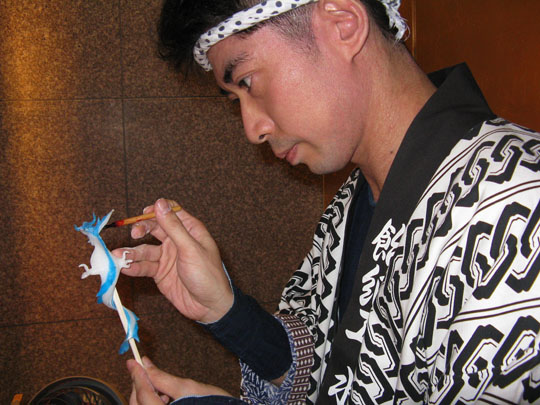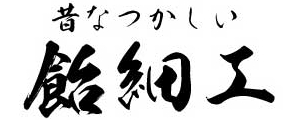'Candy man' conjures up art to eat
By KIT NAGAMURA
Special to The Japan Times

Children and adults swarm the sanzun (small street cart) of Takahiro Mizuki as he creates traditional ame zaiku (candy sculptures).
Plucking out a chunk of scalding mizuame (boiled starch sugar) from a specially heated box at his stand, he bobbles it from hand to hand and stretches it like taffy, increasing the air content and bringing the temperature down a tad so his fingers don't burn.
Then, through swift legerdermain, Mizuki palms tiny dollops of shokubeni (food coloring) and the candy turns first yellow, then green — totally mystifying the kids. As he pinches the still-molten candy into a ball on a stick, though, he prepares for the real show.
In less than two minutes, before the candy ossifies, he snips at the blob with tiny scissors, then tugs, pulls, twists and paints it into a wee edible frog.
Mizuki, 38, can fashion a menagerie of animal creations in traditional shapes that ame zaiku artists have favored since the Edo Period (1603-1867), but he also sculpts bon-bons in icons such as Pegasus, Pikkachu and Pooh, and he takes requests, too.
One customer begs him to make a Chihuahua. Mizuki nods, thinks for a minute, then whips one up, adding a little red ball to one of the dog's front paws "just for fun."
Like many of Japan's traditional shokunin (artisans), Mizuki makes the creative process appear effortless, belying the years of dedication and study behind each step.
"It takes me a day to figure out how to make a new figure," says this resident of Hachioji in western Tokyo. "Then it takes years to perfect it and develop the performance aspect of how the shape will unfold."
Japanese artisan skills are usually handed down through families or from master to apprentice, in a process that hinges not so much on verbal instruction as on observation and imitation. Because his father is in electronics, Mizuki had to learn his trade the hard way — by locating a teacher.
After graduating from college, he spent eight years as a government worker on Niijima, one of the Izu Islands administered by Tokyo off the Izu Peninsula in Shizuoka Prefecture. In 2001, though, he returned to Tokyo when tourism took a jolt from increased seismic activity in the region.
Soon after, Mizuki happened to glimpse an ame zaiku artist on television and, within two days, he'd sought out an artisan at work in the capital. "I couldn't take my eyes off him, and hung around for, like, six hours straight," he recalls.
However, the craftsman was not entirely thrilled by his groupie, and shooed Mizuki away.
Nonetheless, when he made a short visit to relatives in the United States, Mizuki took with him the basic materials for ame zaiku, and tried his hand at it.
How'd it go? "Total fail," he says, "because the stuff was simply too hot to handle. I knew there had to be some tricks involved."
Back in Japan and by now hooked on the mystery of the art, Mizuki traveled to various cities to locate a master who would allow him to observe and learn. He followed two tekiya (stall-keepers), but shakes his head when asked their names. "Some of these guys verge on being racketeers," he admits, "so it's better to leave those details out. But I'm grateful to them for teaching me."
For 10 years since then, Mizuki has practiced to perfect his art, starting with the elementary shape of a little bird, and working up to more complicated sculptures. "The challenge," he says, "is to delight the customer, and be able to create hundreds of works dependably, swiftly, regardless of the season."
And now, he reaps the rewards of his hard work, traveling to Japan's fairs, accepting engagements abroad, and even appearing in commercials and making TV appearances that might inspire followers of his own some day.
Mizuki's current masterpiece creation, and his most expensive at ¥1,500, is a large candy-clawed dragon coaxed from a bi-colored blue-and-white base. He breaks a light sweat making one, pulling it into a swirl around its stick and quickly teasing out sharp talons before the candy grows intractable.
It's clearly a race against time. But the race against time is not limited to candy.
Mizuki distinctly recalls when he first picked up a pair of particularly well-made nigiribasami, the forged and hammered Japanese steel snips that nestle in the palms of ame zaiku artists.
"I happened on a good pair, made in Niigata, and they changed my level of ability," he says, eyeing his nigiribashi. "I bought the last three the shop made. The materials they make them with now are different, and they don't work as well. I'm not sure what I'll do when these wear out."
In addition, though he's still quite young, Mizuki acknowledges that his job takes strength — the cart, the candy, and the tools are heavy to move about, and the days on his feet are hard — and that the years he can continue are limited.
Still, he feels he's now at the top of his game. "I'm moving into a stage where no one can match my skills," he says, "and I'm ready to invent completely new works."
His creations are ephemeral, fragile — and sometimes licked right down to the stick — and there's no denying his work is sweet.
Takahiro Mizuki can be contracted via: info@amezaiku.com ( English or Japanese).
